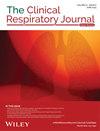The Correlation Between NLR, RDW, and Pulmonary Hypertension in Patients With Bronchiectasis and Chronic Obstructive Pulmonary Disease Overlap Syndrome
Abstract
Introduction
Based on the analysis of the relationship between neutrophil to lymphocyte ratio (NLR) and red blood cell distribution width (RDW) and pulmonary hypertension (PH) in patients with bronchiectasis and chronic obstructive pulmonary disease overlap syndrome (BCOS), this paper aims to explore the indexes that not only represent the severity of patients with BCOS overlapping PH but also are highly related to BCOS overlapping PH.
Methods
The clinical data of 159 patients with BCOS admitted to Qilu Hospital of Shandong University Dezhou Hospital from January 2019 to November 2024 were collected and analyzed. All the patients had complete color Doppler echocardiography at this hospital and were separated into experimental group (106 cases, BCOS with PH) and control group (53 cases, BCOS not combined with PH group), according to whether they were complicated with pulmonary hypertension or not. And then the experimental group was divided into mild, moderate and severe subgroups. The correlation of NLR, RDW with pulmonary artery systolic blood pressure (PASP) in BCOS patients was analyzed. And whether there were differences or not between NLR and RDW among experimental group, control group as well as subgroups was compared. Furthermore, receiver operating characteristic (ROC) curves were constructed to evaluate the efficacy of NLR and RDW in distinguishing between “PH-complicated” and “non-PH-complicated” statuses among BCOS patients at the cross-sectional level.
Results
First, the level of NLR and RDW in experimental group was higher than those in control group, in addition the difference was statistically significant (p < 0.05). Second, significant intergroup differences in NLR and RDW levels were observed among the three subgroups of the experimental group (NLR: p < 0.001; RDW: p = 0.011). Specifically, both NLR and RDW levels in the severe PH subgroup were significantly higher than those in the mild PH subgroup (NLR: adjusted p < 0.001; RDW: adjusted p = 0.009). Additionally, NLR levels in the severe PH subgroup were higher than those in the moderate PH subgroup (adjusted p = 0.011), whereas no statistically significant difference in RDW levels was noted between the severe and moderate PH subgroups (adjusted p = 0.148). Furthermore, there were no significant differences in NLR or RDW levels between the mild and moderate PH subgroups (NLR: adjusted p = 0.196; RDW: adjusted p = 0.607). Third, the level of NLR and RDW was positively correlated with PASP (r = 0.294, 0.259; p < 0.05). Fourth, Multivariate logistic regression analysis revealed that decreased PO2, NLR, and RDW are independent risk factors for PH development in BCOS patients (all p < 0.05). Fifth, ROC curve results showed the areas under the curve (AUC) of NLR, RDW and their combined detection in differentiating BCOS patients with and without PH were 0.628, 0.751, and 0.756 respectively. In particular, RDW performed better than NLR in differentiating with regard to discriminative ability. Furthermore, compared to RDW, the AUC of the combined detection was higher, meanwhile, its specificity was greatly enhanced than both single indicators. These results indicate that the combined detection exhibits better capability in identifying PH complicating BCOS at the cross-sectional level.
Conclusions
The level of NLR and RDW is related to the severity of pulmonary arterial pressure in patients with BCOS. The two indicators can serve as a significantly relevant factor for pulmonary hypertension complicating BCOS.


 求助内容:
求助内容: 应助结果提醒方式:
应助结果提醒方式:


